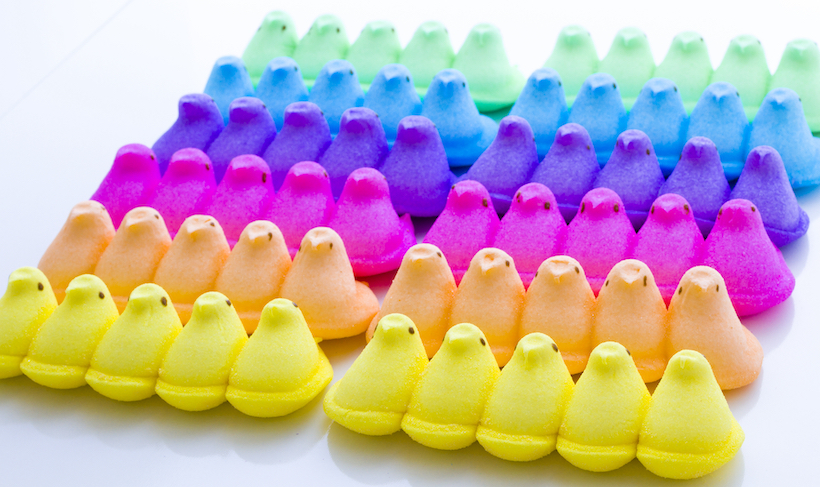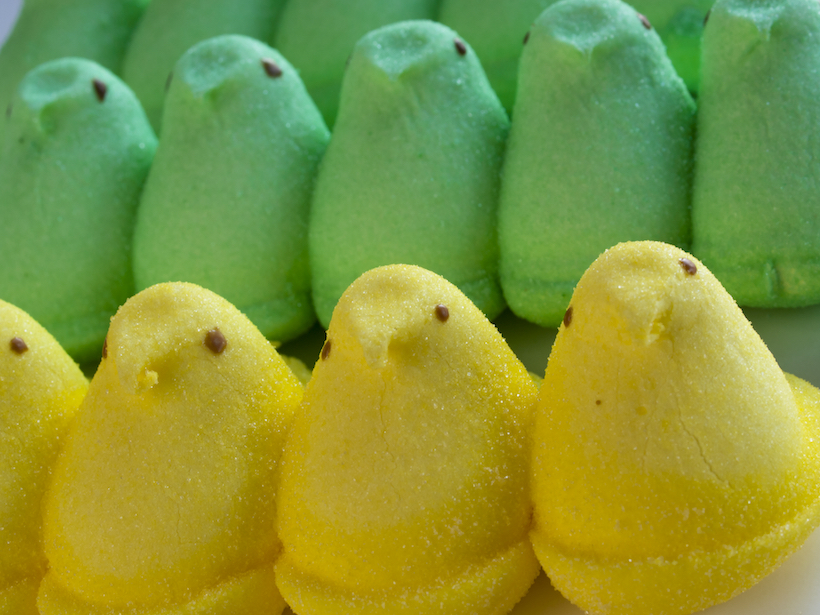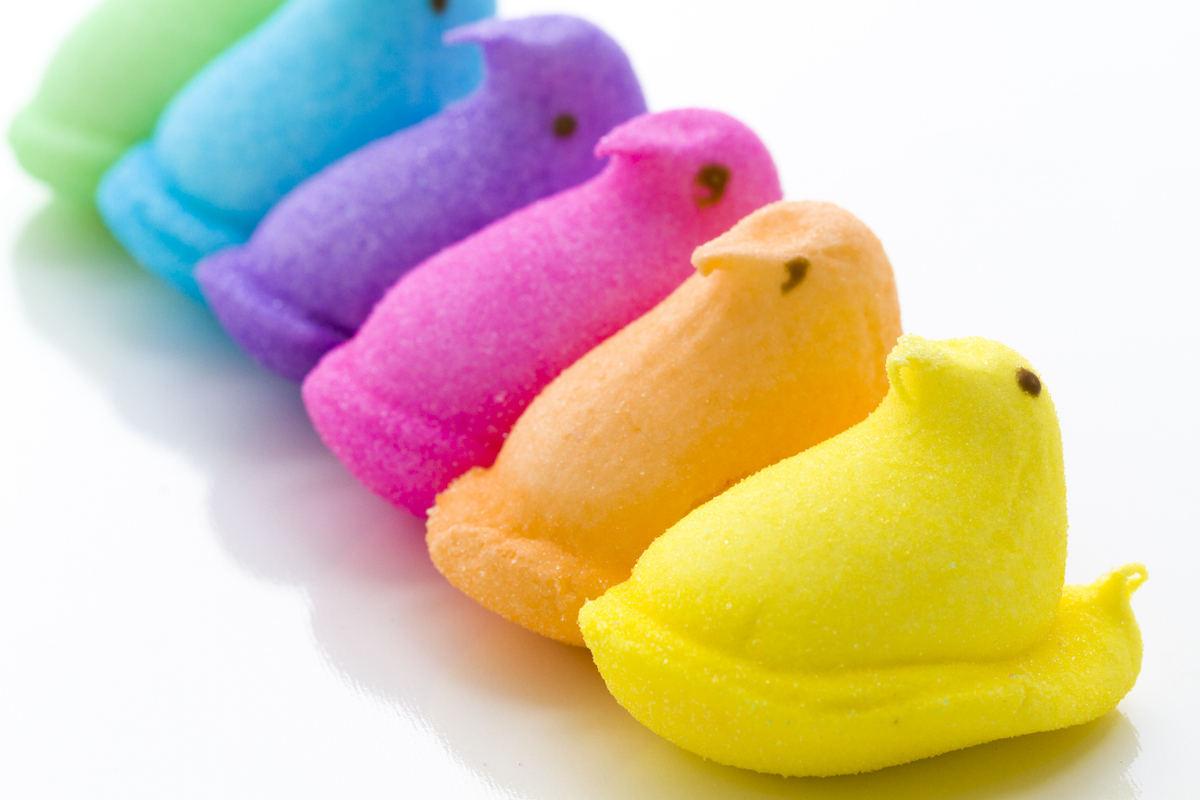Do you have fond memories of the sugary chicks that arrive in Easter baskets every year? Even as adults, many of us secretly indulge in Springtime Peep-eating, even those of us who insist rather loudly that they're their "least favorite candy".
Love them or hate them, Peeps are ubiquitous around Easter.
These marshmallow treats have a fascinating history—one including immigration, innovation, and industrialization. Let's take a peek at the history of Peeps!

Classic Peeps are marshmallow candy made of a simple mixture of sugar, corn syrup, and gelatin. They include a few other ingredients, such as preservatives and food coloring, but each Peep is essentially a colorful, chick-shaped marshmallow treat – with wax eyes. Specialty products and particular colors may contain additional ingredients, but that's nearly the full story.
A single serving of five chicks comes to 140 calories. According to Just Born, they contain no fat but a whopping 30 grams of sugar—60% of the daily value for people on a 2,000-calorie daily diet.
Peeps come in various shapes, including the original yellow chick, its friend the Peeps bunny, and various other seasonal offerings. If you keep your eyes peeled, you'll notice that there are Christmas Peeps, Halloween Peeps, and all manner of other Peeps for other holidays.
Specialty flavors now range from fruit to chocolate, including:
The Peeps candymakers dip some varieties—sold as "delights"—in chocolate or fudge, inject others with ganache, or dust them with chocolate sprinkles. Just Born also sells miniature versions of the popular treats, as well as Peeps bunny pops.
Despite the wide variety of marshmallow-based Peeps, Just Born offers sugar-free options for people with diabetes that have a sweet tooth, as well.

Humans have sculpted desserts out of sugar for hundreds or perhaps thousands of years... if you really want to go back to the beginning.
Although we don't really know the provenance, there is a long tradition in Chine for forming heated sugar into people and animals' shapes. Though these creations were (and are) edible, they were created primarily as art for people to view – not candy for people to digest.
Europeans from the late Middle Ages to the present day made elaborate sculptures from sugar.
Across cultures, intricate flowers have long been a popular choice, especially on top of wedding cakes. Dessert artists have crafted elaborate dioramas out of sugar depicting military engagements, passages from the Bible or mythology, and other artful scenes.
For many years, children have also delighted in sugary desserts with soft and wispy textures (such as cotton candy) and tough geological ones (rock candy).
In 1910, a young Jewish man named Sam Born fled anti-Semitism in his home country of Russia and immigrated to the United States.
The 19-year-old Born came from a family of chocolatiers and went to work in Brooklyn, New York, plying the family trade.
But Born was incredibly inventive. In 1916, Born invented a lollipop machine. His "Born Sucker" machine automatically inserted sticks into the hard candy. (A sucker born every minute, indeed.) He followed up with improvements to the processes of making chocolate sprinkles and chocolate coatings.
By 1923, Born had earned enough money to open his own retail store. He called it Just Born as both a play on his name and an advertisement that Born freshly made its candies each day.
Over the next few years, Born continued to expand and purchase competitors' brands. He moved production to a massive factory in Bethlehem, Pennsylvania. In 1940, Just Born began producing another popular candy you've heard of, Mike and Ike. A decade later, they introduced Hot Tamales (which – by the way – has also inspired a Peeps flavor).
The Rodda Candy Company was based just down the road from Just Born in Lancaster, Pennsylvania. The company was best known for its jelly beans and had developed a reputation in the confectionary world for its efficient jelly bean production technology. In 1953, Just Born purchased Rodda and started incorporating their techniques into the candy line.
While best known for jelly beans, Rodda authorities also had a beloved side project—a line of three-dimensional, chick-shaped marshmallow treats, Peeps. The chicks even had wings!
Though customers loved the original Peeps, each batch took forever to produce. Workers mixed all the ingredients then hand-squeezed each Peep through a pastry tube to form individual marshmallows. It took a team of dozens of workers 27 hours to produce a single batch of marshmallow candy.
(And by the way, Just Born would launch its own jelly bean line, Teenee Beanee, in 1977, using Rodda's techniques.)
The original Peeps were handmade, but Sam's son Bob Born figured out how to automate the process, sending marshmallows shooting out of the pastry tube in record time. He successfully reduced a job that once took 27 hours to just six minutes. The chick-shaped original Peeps lost their wings in the process but were on their way to becoming an annual stable in Easter baskets across the United States.
Over the decades, Just Born rolled out new varieties, sizes, and colors. White and yellow were the original hues, and yellow Peeps continue to outsell other colors, such as pink, blue, and lavender. Peeps have also long been the most popular non-chocolate Easter candies. Despite the introduction of more modern designs, 70% of all Peeps sold in the United States today are sold around Easter.
While Peeps are now available in retail stores across the United States and Canada, Just Born occasionally grants some retail stores exclusive rights to a particular flavor.
For example, in 2021, Target obtained exclusive access to chocolate caramel swirl Peeps dipped in chocolate, as well as giant Peeps bunny pops. One year, Walmart earned the supply of blue raspberry marshmallow chicks and individually-wrapped Peeps that fit inside plastic eggs
Such a controversial candy means you're bound to find all sorts of zany Peeps-related statistics when you start looking around. Well – I did.
Here are all the Peeps facts, stats, and trivia you wanted to know – and a few things you didn't.
Peeps are legendarily durable, with a reputation for being nigh-indestructible. In 1999, Emory University researchers subjected Peeps to boiling water, sulfuric acid, sodium hydroxide, and acetone. The scientists observed that the Peeps demonstrated "apparent invulnerability" to every substance.
It took an hour submerged in Phenol to wear down a marshmallow chick finally. Phenol, you might note, is a potentially lethal chemical used to strip the paint off of airplanes that can cause chemical burns to human flesh.
Do you think you can eat a lot of Peeps? Sign up for one of the many Peeps-eating contests held around the United States every year. But come hungry—competitors routinely polish off more than 200, even 250, treats in just five minutes.
Just Born jovially estimates that about a quarter of its customers ignore their expiration dates—which is to say that they prefer their Peeps stale.
I mean, I get the crunch... but do you like them that way?
Peeps – okay, or suspiciously Peeps-like marshmallow products – are frequent guest stars on comedy series. They have appeared in "South Park," "The Good Place," and "Malcolm in the Middle."
Peeps are multiplying. Each year, 509 Peeps "hatch" in relation to each human birth. That amounts to 2 billion Peeps every year—or enough to wrap around the Earth twice, with plenty of room to spare. Just Born produces so many Peeps that you could stack the amount made in two minutes as high as the Empire State Building.
Every year, intrepid eaters invent new styles of Peepshi—that's Peeps sushi.
The food-enthusiast website Serious Eats hatched the idea a decade ago to enthusiastic response. Besides the marshmallow treat, aficionados use Nerds, Fruit-By-The-Foot, Rice Krispies Treats, and other confections.
Children, the young-at-heart, and all manner of other fun people have long enjoyed Peeps jousting.
The "sport" involves pricking two chicks with toothpick lances, putting them in a microwave, watching them swell up (they get very large), seeing which one pops the other first... then furiously cleaning said microwave.

Regardless of their controversy – seriously, they get almost as much heat as candy corn – these sugar-filled marshmallow treats are not likely to go out of style anytime soon. And whether you eat your Peeps or set up elaborate jousting scenarios in your microwave, I hope you enjoyed reading about their history. Bite in!
When I was a child about 4 yrs old (born in 1957) on way to baby sister I got to pick a treat from candy store. It was a marshmallow hot dog & I have neve seen again when looking in retro candy shops. I did see a candy hot dog but it wasn’t the same. The one I remember tasted just like a peep; any connection?